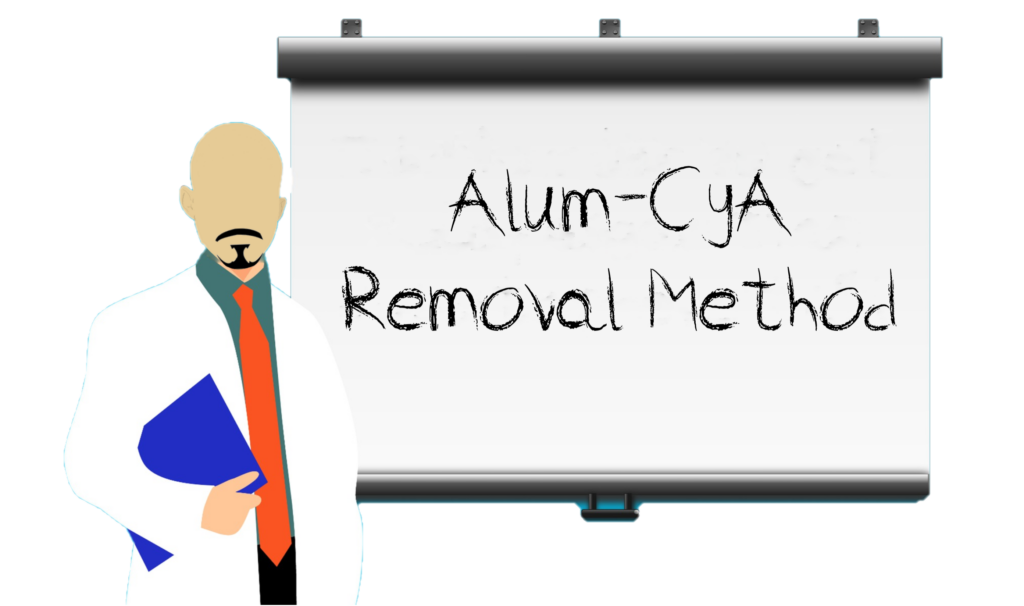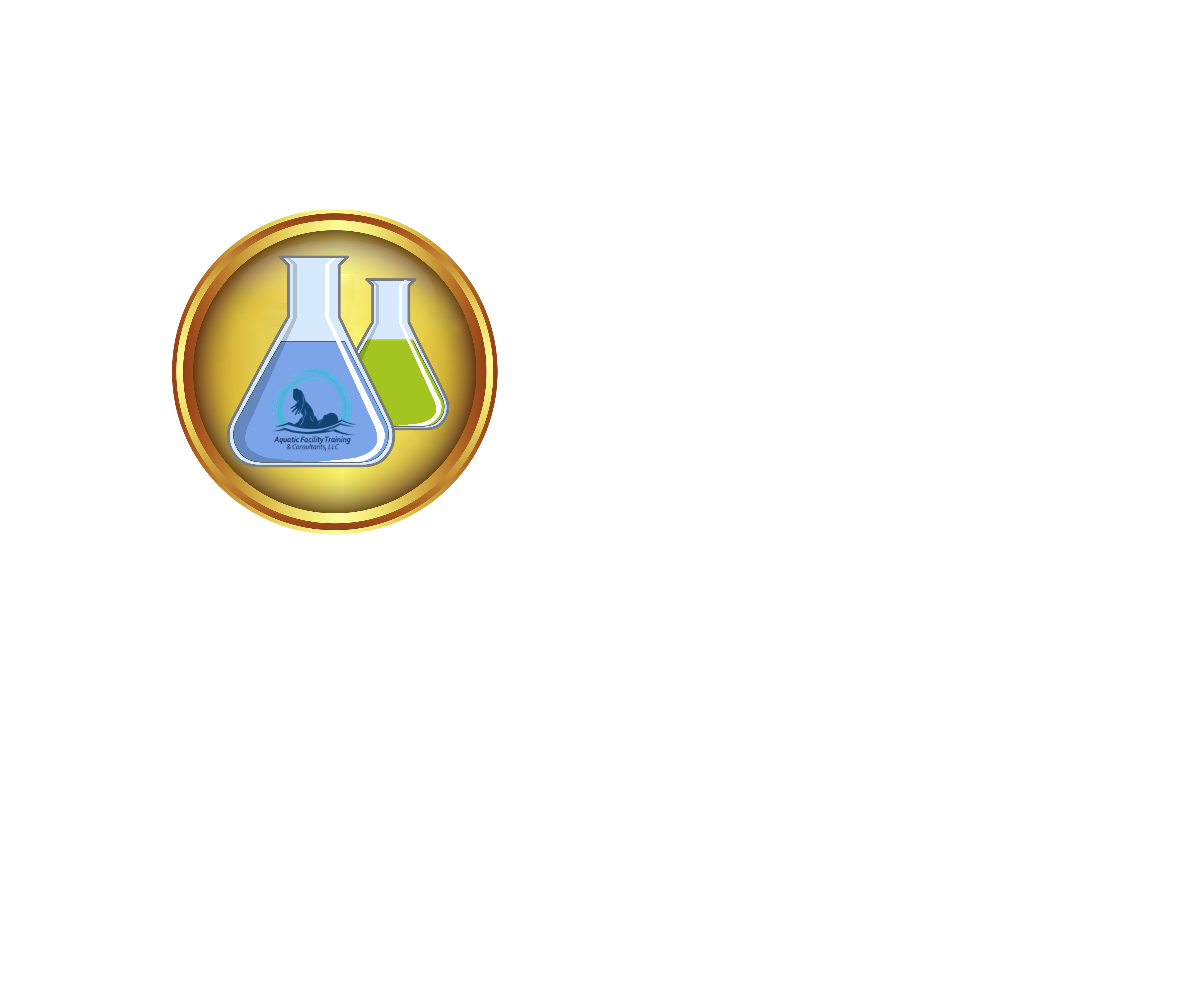In mid-October of 2020, Robert W Lowry released an Alum-CyA ‘Tech Bulletin’ titled ‘Does Alum Remove CyA?’ This appeared again in the Service Industry News publication several weeks later. His article directly responded to an announcement I had made at the 2019 International Pool, Spa, & Patio Show in New Orleans while participating in ‘The Great Cyanuric Acid Debate.’ The Panel consisted of Richard Falk, Ellen Meyer, PhD (Product Safety and Government Affairs Manager at Sigura), Dr. Roy Vore, Microbial Physiologist (Technology manager at Bio-Lab, Inc), and myself.
[responsivevoice_button voice=”UK English Male” buttontext=”Listen to Post”]

Alum-CyA Removal Method.
I had spent that summer experimenting with using Alum (Aluminum Sulfate) as a means of chemically removing cyanuric acid from swimming pools. Upon sharing news of my success, I had many Pool Pros volunteer to help in field trials and data collection. In each instance, the field professionals experienced the same results – a 30 to 50% (temp dependent) or greater drop in CyA ppm. All utilized a spin touch or visual determination test. Spot checks for aluminum residual have followed the process and have proven in each case to be less than the EPA Secondary Contaminant Aluminum max level of 0.2 ppm. Alum-CyA method: Alum CyA Removal Method Step-By-Step
Natural Chemistry 07200 PHOSfloc Pool Water Balancer, (Aluminum Sulfate Product)
Alum-CyA ‘Tech Bulletin.
Lowry’s ‘Tech Bulletin’ does a beautiful job explaining how aluminum sulfate works as a coagulant and its use to remove negatively charged suspended particles. I agree that is the typical use. He gives several examples of why ‘floc’ would not remove cyanuric acid and refers to his ‘logic’ as science-based conclusions.
Metal Complexation.
The truth is we don’t believe that alum can ‘floc’ dissolved cyanuric acid out of solution either. Instead, our research focused on metal complexes that form with cyanuric acid. This is best represented in the well-known formation of copper-cyanurate Na2[Cu(H2C3N3O3)4] · 6H2O in swimming pools that have both a copper level and high ppm of CyA (cyanuric acid). There is also an abundance of literature documenting silver-cyanurate formation (AgH2C3N3O3) when silver nitrate is added to a CyA solution. Many other metals also make the list. I admit I was a bit surprised when the former industry scientist completely missed complexation in authoring his document.
Aluminum Sulfate Theory.
What we have proposed since inception was the formation of the insoluble complex aluminum-cyanurate Al(H2C3N3O3)3 when alum [Al2(SO4)3] is added to water with a level of cyanuric acid. Unfortunately, as the retired scientist states, ‘There is no evidence in the scientific literature that states alum (aluminum sulfate) can be used to lower or remove cya.’ However, there is evidence in scientific literature that states aluminum in a +3 oxidation state will form aluminum-cyanurate (Seifer, 2002 – refers to the formation of aluminum cyanurate and with a formula Seifer documents as H[AlO(HC3N3O3)]·2H2O, however, his research likely was conducted with a > 10.0 pH. For the pH ranges we typically keep in swimming pools Al(H2C3N3O3)3 is likely to result). Al+3 (aluminum) ions are what you get when Alum dissociates in water. We have had much support from other pool industry scientists and chemists on this theory.
Aluminum in a +3 oxidation state.
Alum is Al2(SO4)3; when put in water, it splits into Al+3 (aluminum) ions and SO42-(sulfate) ions. Water is H2O. It can split into H+ (hydrogen) ions and OH- (hydroxide) ions. The aluminum ions can combine with the hydroxide ions to form insoluble floc, which is Al(OH)3. Therefore, Al+3 (aluminum) ions from alum can also combine with C3H3N3O3 (cyanuric acid) to form insoluble Al(H2C3N3O3)3 which is aluminum-cyanurate.
What the Floc?
Here is the cool part, because this is really a one-two punch. Once the insoluble aluminum-cyanurate forms, it can get ‘caught up’ in the aluminum hydroxide [Al(OH)3] floc. This expedites the precipitate allowing for an easy vacuum to waste. Thus the ability to successfully lower cyanuric acid without the need to drain the pool beyond the three to four inches of water lost in a slow vac to waste.
The bulletin did state that several individuals had reported stating a rise in cyanuric acid following the alum-CyA removal method. I have not received such information. Thus far, all field trials have recognized an entire season with an increase only in normal increments over months due to trichlor added. I have asked upon the bulletin’s initial release to speak with those individuals Lowry claims had experienced a ‘return in CyA’; however, that request has gone unanswered. So, if you have had this experience, we’d like to know about that too. Your process needs to be factored in as we continue to fine-tune this method.
Heavy Metals!
Oddly enough, and we may as well address this here, there are others who are raising concerns about our use of aluminum in lowering cyanuric acid, phosphates, removing copper stains, and as a coagulant in general. This is the same method over 60% of US municipalities use in water treatment. So, the water from your tap and in your pools has most likely already been treated with alum.
Besides, as mentioned above, our spot checks for aluminum residual have followed the process and have proven in each case to be less than the EPA Secondary Contaminant Aluminum max level of 0.2 ppm. National Secondary Drinking Water Regulations (NSDWRs), are non-enforceable guidelines and in place for matters that may slightly affect the taste.
Copper, Silver, and Lanthanum.
Raising unease in a proven water treatment method that leaves near nil residual in an industry that frequently uses heavy metals such as copper sulfate (copper algaecides), colloidal silver (silver algaecides), and lanthanum (phosphate removers) is baffling. In fact, the industry does not even have a means of testing residual lanthanum. Forwarding samples for lab analysis is required.
A special thanks to all of the pool professionals who have volunteered to test this method over the past year. They have done so with expense completely out of pocket and without the potential for monetary gain. Pool men and women have collected and reported data from their field trials. This research is essential because, unlike lab trials, the information received is quantitative, qualitative, and does not lack external validity. They have done this only intending to fix an existing problem to make the swimming pool industry better. Pool Pros Rock!
Like & Share This Post
references
Seifer, G. (2002). Cyanuric Acid and Cyanurates. Russian Journal of Coordination Chemistry, 28, 301-324.








Thanks for making this personal instead of professional. I am not retired. I am not former and I tried to ask some reasonable questions about the method to gain some insight and prove the method. I mentioned your name once as the creator of this method to give you credit. Since then because I ask questions and raise doubts you consider me an enemy. I guess if I disagree with you then I am an enemy. I did not say the method did not work. I did say If effective, “this would be a better way to lower CYA levels than draining. This method should be given more research and study.” “There are some questions and observations I have about using alum (aluminum sulfate) for CYA reduction or removal. I am not saying it does not work. ” “There is no evidence in the scientific literature anywhere that states alum (aluminum sulfate) can be used for lowering or removing CYA. This does not mean that it cannot be used for CYA reduction or that it does not work for that purpose. It only means that no one has documented or studied alum for CYA removal and published their work. ” “I want to prove that this works before we all start recommending it only to find out that it doesn’t.” I especially want to understand why it removes a percentage of CYA instead of a ppm removal due to a calculated dose. And here is another chance for you to attack me for questioning you.
Whoa. Slow your roll Bob; I honestly don’t think my response was personal or an attack. I did state that I agreed with you on several points. You did miss the premise of my theory in your tech bulletin, so my response offered that explanation. Your bulletin also stated that there was no scientific literature available, which is incorrect, so I did cite that research document, supporting my theory. I apologize that I thought you had retired; I don’t see that as a reason to go into a tizzy. I do agree, as I had said from the start, that more research is needed.
I want to say that this needs to be a healthy conversation within our industry, NOT a debate—peer to peer. To take a process that many of us have been working with, providing real-world results and cast shadow is a disservice. And as an industry, it is destructive.
I also think that we are discussing 2 different situations. 1-Over saturated pools with extremely high CYA 2-the varying degree of CYA removal when using alum to floc a pool
Well said, Ken, and thank you for reading. I’m not sure the intent of the Lowry tech bulletin’s allegements, but I agree to naysay at this point is remiss.